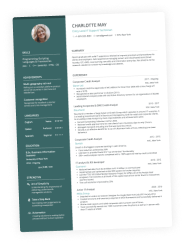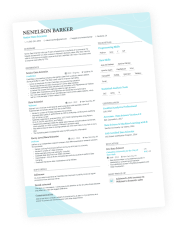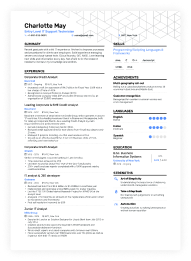The conversation around sharing personal pronouns in professional settings is gaining momentum.
Major companies like SAP have recognized the importance of acknowledging individuals' pronouns, making this a topic of both sensitivity and significance. For some, it’s about fostering inclusivity and respect, while for others, it’s about maintaining privacy and avoiding unnecessary bias.
But what about including pronouns on your resume? Should you make your identity clear right from the start, even before you step into an interview? Or could it impact your chances of getting the job?
In this article, we’ll take a balanced look at the pros and cons of disclosing personal pronouns on a resume. We’ll also explore how different job environments may affect this decision and provide practical tips for those who choose to include them.
Let’s begin.
Key takeaways
- Featuring pronouns on your resume is a personal choice that can promote authenticity but may expose you to bias.
- Aside from your resume, other options to add your pronouns are LinkedIn, email signatures, or cover letters.
- Research company culture before including pronouns to ensure it aligns with inclusivity.
- Gender selection in online applications is optional—choose what best represents you or skip it.
- The presence of pronouns can prevent misunderstandings, especially if your name is gender-neutral or uncommon.
- Consider your industry. Progressive fields may welcome pronouns, while traditional ones may not.
What are personal pronouns?
Personal pronouns are words used to refer to people without using their names. They help clarify how someone identifies and how they would like to be addressed. In the context of gender identity, personal pronouns are a way of acknowledging and respecting an individual's identity.
Here are some common examples:
- He/Him/His: Typically used by those who identify as male.
- She/Her/Hers: Typically used by those who identify as female.
- They/Them/Theirs: Often used by those who identify as non-binary, genderqueer, or who prefer gender-neutral language.
- Other pronouns: Some individuals use less common pronouns like ze/zir, xe/xem, or fae/faer, reflecting a more personalized expression of identity. These can lead to confusion or misunderstanding.
Why are personal pronouns important in the workplace?
We spend a significant portion of our lives at work, so feeling safe, respected, and valued is crucial. For many, this means being addressed by their correct pronouns to show respect, support inclusion, and help avoid misunderstandings.
Inclusive workplaces that recognize diverse identities are better at creating a sense of belonging. But while using pronouns at work is becoming common, deciding whether to list them on a resume is a more complex question.
Navigating gender selection in online job applications
Online job applications often ask candidates to select their gender. If the form offers options like “genderqueer/nonbinary,” choose what best represents you.
If it only provides “male” or “female,” you can select “other” or “prefer not to disclose.” This information is typically used for diversity reporting, not hiring decisions, and is usually optional—you can skip it if you’re uncomfortable.
Should you put pronouns on your resume?
We’ll help you decide with a simple step-by-step flow.
Step 1. Do your research
If you’re concerned about bias, consider researching the company's values and culture before applying. Look for signs of inclusivity, such as diversity statements, employee resource groups, or testimonials from current employees.
If a company appears non-inclusive, you might choose to avoid applying, especially if being respected for who you are is a priority.
Step 2. Consider your sector
Some industries, like tech, media, and creative fields, are naturally more progressive. In these environments, sharing your pronouns may be welcomed.
But in traditional sectors like finance, law, or manufacturing, personal details may be seen as unnecessary. A software developer applying to a Silicon Valley company may feel comfortable including pronouns, while an accountant applying to a regional bank might decide against it.
Step 3. Assess your safety and well-being
Your comfort comes first. If sharing your pronouns makes you anxious or puts you at risk, it may be best to focus your resume purely on your skills and experience. If you’re unsure how a company will react, there’s no harm in leaving pronouns off.
You can always introduce them later—in a cover letter, LinkedIn profile, or during an interview—if you feel comfortable. We’ll discuss your options below.
Let’s also review some pros and cons.
Why including pronouns on your resume can be a good idea
Transparency on your resume can be great if you want to be clear about who you are from the get-go.
Here are some strong reasons to include pronouns in your document:
Authenticity and inclusion
Outlining your pronouns can help you stay true to yourself throughout the job application process. It ensures that potential employers know how to address you respectfully, which can help you feel more comfortable and confident.
Promoting an inclusive culture
Using pronouns on your resume can signal that you value diversity and inclusion. This may resonate with employers who prioritize creating a welcoming workplace. It can also subtly highlight your awareness of modern, respectful communication practices.
Navigating inclusive workplaces
Sharing your pronouns can prevent any confusion or awkwardness later in the hiring process. This is especially helpful if your name is gender-neutral or uncommon, where assumptions might otherwise be made.
Why you might want to skip pronouns on your resume
All things considered, you might decide not to include pronouns on your resume, and that's perfectly okay. While transparency can be a strength, there are also potential risks and downsides that are worth considering.
Let’s review some of them.
Bias and discrimination
Unfortunately, we can’t predict what all the people in our new workplace will be like. Including pronouns on your resume could expose you to unconscious bias or even outright discrimination, especially in industries or regions that may not prioritize diversity.
Regional or industry differences
In the US, the Equal Employment Opportunity Commission (EEOC) prohibits discrimination based on gender identity under Title VII of the Civil Rights Act.
However, attitudes toward pronouns can vary widely depending on location. For instance, a progressive tech company in California may value your openness, while a more traditional organization in a conservative region may not.
Relevance to job performance
For most roles, your gender identity isn't directly relevant to your skills or ability to perform the job. Some applicants may prefer to keep their resumes focused purely on their qualifications without introducing personal details.
Where to include pronouns on your resume
If you do opt for pronouns on your resume, the most logical placement is in your resume header.
Add them directly next to your name to make it easy for employers to know how to address you without distracting from your qualifications.
Let’s say you don’t want to feature your pronouns on your resume for some reason. That doesn’t mean you can’t share them at all.
Instead, you can include them in other professional spaces, such as your LinkedIn profile, email signature, or even your cover letter.
LinkedIn: Showcasing your pronouns professionally
LinkedIn profiles are a public representation of your professional identity, and adding pronouns here can help you communicate them consistently.
You can include pronouns directly next to your name, in the “About” section, or even in the headline. This approach ensures that anyone who views your profile knows how to address you without making it a primary feature of your resume.
For instance:
Name: Alex Smith (they/them)
Headline: Content Writer | Inclusive Storyteller | They/Them
About: "Hi, I’m Alex (they/them), a creative content writer passionate about storytelling that makes a difference. I specialize in creating authentic, inclusive content that resonates with diverse audiences."
Cover letter: Introducing your pronouns with context
A cover letter is another space where you can comfortably share your pronouns, especially because it's a personalized document.
By including your pronouns in your introduction, you help set the tone for respectful communication from the very beginning. This can be done subtly and professionally within the opening paragraph, making it clear without drawing unnecessary attention.
For instance:
"Dear Hiring Manager,
My name is Alex Smith (they/them), and I am excited to submit my application for the Content Writer position at [Company Name]. With over five years of experience in crafting inclusive, high-impact content, I am confident in my ability to contribute to your team."
You could also add your pronouns directly to your sign-off.
Email signature: Consistent and clear communication
Displaying your pronouns in your email signature ensures that everyone you communicate with knows how to address you correctly, even before a conversation begins. This can be particularly useful for ongoing professional communication, whether you’re applying for a job, networking, or communicating with clients.
For instance:
Sincerely,
Alex Smith
(they/them)
Some worry that including pronouns on a resume may be seen as virtue signaling—presenting them more for appearance than for authenticity. This perception depends on context. In inclusive environments, pronouns show respect and clarity. In conservative settings, they may be misunderstood.
To avoid this concern, keep pronouns subtle but clear, like in your LinkedIn profile, email signature, or the closing of a cover letter. This allows you to share them naturally without making them the focus.
Should you write your resume in the first person?
When considering whether to include personal pronouns on your resume, it's also important to think about the overall perspective or “person” in which your resume is written.
Traditionally, resumes are written in an implied first-person narrative without explicitly using pronouns like "I" or "me." This approach keeps the focus on your achievements and skills while maintaining a professional tone.
For instance
Instead of writing, "I developed marketing strategies that increased sales by 30%," you would write, "Developed marketing strategies that increased sales by 30%." This style is concise and directs attention to your accomplishments without unnecessary repetition of pronouns.
However, there are exceptions. In sections like the resume summary or objective statement, using the first person can add a personal touch and convey enthusiasm. Even then, it's advisable to use it sparingly to avoid sounding self-centered.
Frequently asked questions about pronouns on a resume
Anything else on your mind? See if we’ve covered it below.
Can I use a nickname or preferred name on my resume?
Yes, you can use a nickname or preferred name on your resume for clarity. We suggest formats like "Elizabeth 'Liz' Johnson" or "Elizabeth (Liz) Johnson." This ensures recruiters recognize you without confusion.
For preferred names reflecting your identity, maintain consistency across your documents. In formal industries, your full legal name may be safer, but you can include both for balance.
How do I handle bias during the hiring process?
If you experience bias during the hiring process, stay composed and document the incident. If it's subtle, such as uncomfortable questions or assumptions, you can redirect the conversation to your qualifications.
For direct discrimination, consider addressing it politely but firmly (“I prefer to focus on my skills and experience for this role”).
After the interview, you can decide whether to pursue the job based on the company's response. If the bias is serious, you can report it to the company's HR department or, in extreme cases, file a complaint with a relevant regulatory body (like the EEOC in the US).
What should I do if an interviewer misgenders me?
If an interviewer misgenders you, stay calm and politely correct them. You could say something like, "Actually, I use [your pronouns], but no problem!"
Maintaining a positive and professional tone keeps the conversation respectful and minimizes discomfort. If you feel uncomfortable addressing it immediately, you can clarify your pronouns in a follow-up email. Remember, how they respond can also help you gauge if the company is an inclusive environment for you.
Will including pronouns affect my chances of getting a job?
Disclosing pronouns on your resume can be an advantage in inclusive companies that value diversity, but it may lead to bias in conservative settings. Researching the company’s culture can help you decide whether pronouns are likely to be seen positively or misunderstood.
How do I know if a company is inclusive?
Here’s a simple checklist you can follow when researching a company:
- Use LinkedIn to review employee testimonials.
- Check Glassdoor for DEI-related comments.
- Visit the company’s website for diversity statements.
- Look for employee resource groups or DEI certifications.
If the company lacks clear inclusivity initiatives, you might consider sharing your pronouns only on your LinkedIn profile or email signature instead.
Additionally, be prepared to confidently and professionally address your pronouns if asked during the interview process.
Should I include pronouns if I apply internationally?
You might wonder what the work environment is like outside the US.
European countries are increasingly open to adding pronouns to a resume, but acceptance can vary by industry. In contrast, some regions in Asia, the Middle East, and Latin America may view pronouns on a resume as unconventional. Understanding the cultural context of your target job market can help you decide whether to include pronouns.
Conclusion
Ultimately, what you put on your resume is entirely your choice. There's no one-size-fits-all answer to whether you should add personal pronouns. It’s a personal decision shaped by your beliefs, comfort, industry norms, and the type of employers you’re targeting.
If you decide to include pronouns, you’re making a statement about authenticity and inclusion. If you choose not to, you’re focusing purely on your skills and experience. Both choices are valid.
Stay informed about evolving practices across industries, and remember that you can always adjust your approach depending on the opportunities you’re pursuing. The most important thing is to make a decision that aligns with your values and feels right for you.
Make one that's truly you.



